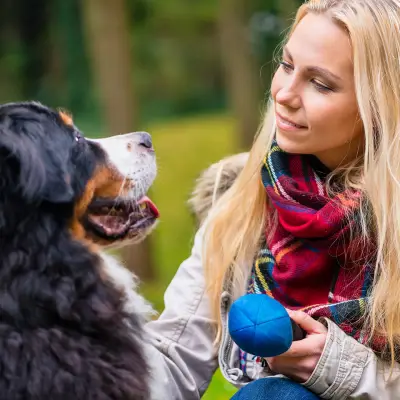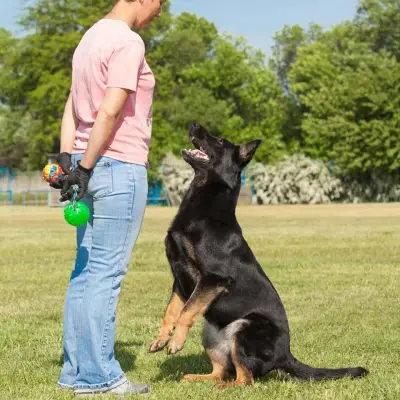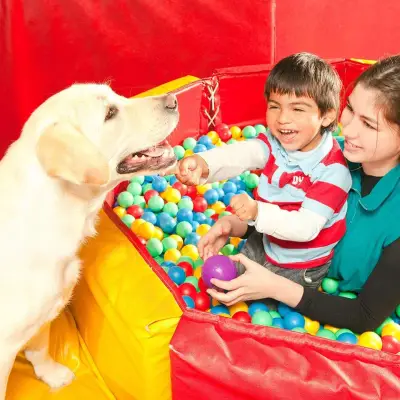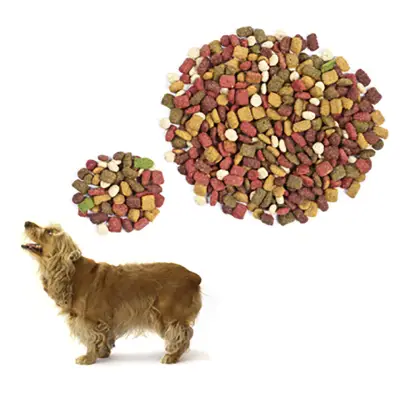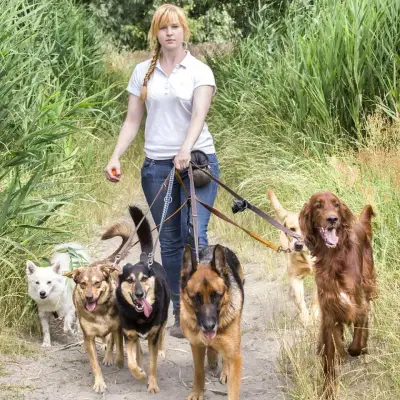Teaching your dog to stay is one of the most useful and reassuring commands you can give. Whether it’s preventing door dashes, managing excitable greetings, or helping your dog stay calm in busy environments, the stay command is an essential skill that makes everyday life easier and more enjoyable.
This guide walks you through how to teach a dog to stay, with effective techniques and troubleshooting tips. You’ll learn what to expect, how to keep your dog motivated, and how to build a stay that works even in challenging situations.
Jump to:
- How Do You Teach a Dog to Stay?
- Why Teach a Dog to Stay?
- How Long Does It Take a Dog to Learn to Stay?
- What You Need Before You Start
- How to Teach Stay to a Puppy or Adult Dog: Step-by-Step
- What Is the Difference Between Wait and Stay?
- Should I Teach My Dog Stay or Come First?
- How to Train Your Dog to Stay With You Off-Lead
- Training Tips and Troubleshooting
- Frequently Asked Questions
- Study Our Dog Training Diploma for £29
Recommended for you!
Best SellersHow Do You Teach a Dog to Stay?
If you're looking to teach your dog to stay, here’s a brief summary:
- Choose consistent cue and release words
- Begin with short durations and build gradually
- Introduce distance and distractions over time
- Reward successes generously
- Practice regularly, in different settings
- Always use the release cue to end the stay
We’ll get into a more detailed explanation of each step later in this blog post.
Why Teach a Dog to Stay?
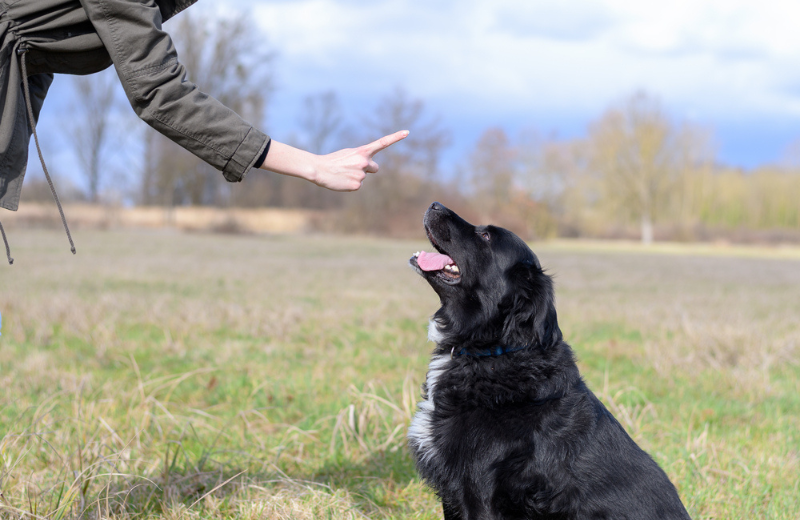
Stay is more than a basic obedience command. It helps your dog develop self-control, patience, and focus, which in turn builds a stronger relationship between you both. Teaching your dog to stay can prevent accidents, encourage calmness in public, and make everyday situations much easier to manage.
Whether you're opening a door, greeting visitors, or asking your dog to pause at the kerb, a reliable stay allows you to stay in control and keep your dog safe. It's often one of the first commands taught because it lays a foundation for other important skills like recall, polite manners, and walking nicely on the lead.
How Long Does It Take a Dog to Learn to Stay?
The time it takes to teach a dog to stay depends on your dog’s age, temperament, and how consistent you are with training. Some dogs pick it up in a few days, others may need a few weeks of steady practice. Puppies generally take longer, as they’re still learning to focus, but the process is the same. Stick with it and celebrate small improvements. Patience is key when teaching your dog to stay.
What You Need Before You Start
To begin training your dog to stay, you’ll need:
- A calm environment with few distractions
- Plenty of small, high-value treats
- A lead or harness (optional for early sessions)
- A consistent cue word and release word
- A bit of patience and a positive attitude
You’re now ready to begin teaching your dog the stay command.
How to Teach Stay to a Puppy or Adult Dog: Step-by-Step
Step One: Choose Your Stay Cue
Start by selecting a simple, consistent word to signal the stay command; most commonly, “stay”. Say it clearly and calmly each time you use it. Pair the word with a visual signal too, such as holding up your palm like a stop sign. This hand gesture can help reinforce the command, especially in noisy environments or from a distance.
At this stage, don’t worry about the release word. The focus should be on helping your dog understand what “stay” means and beginning to associate it with holding their position.
Step Two: Start With Position and Timing
Ask your dog to sit or lie down. Show your open palm (like a stop sign), and clearly say “stay”. Wait just one or two seconds, then reward your dog with a treat and praise, even if they only stayed for that short moment.
Repeat several times. End the session before your dog gets bored.
Step Three: Extend the Duration
Once your dog reliably stays for a few seconds, begin to slowly increase the time. Wait 3–5 seconds, then 7–10, building up to 30 seconds and beyond. Don’t rush; success comes from small, steady progress.
If your dog gets up early, calmly place them back in position and try again. There’s no need to scold, as this is all part of learning.
Step Four: Add Distance
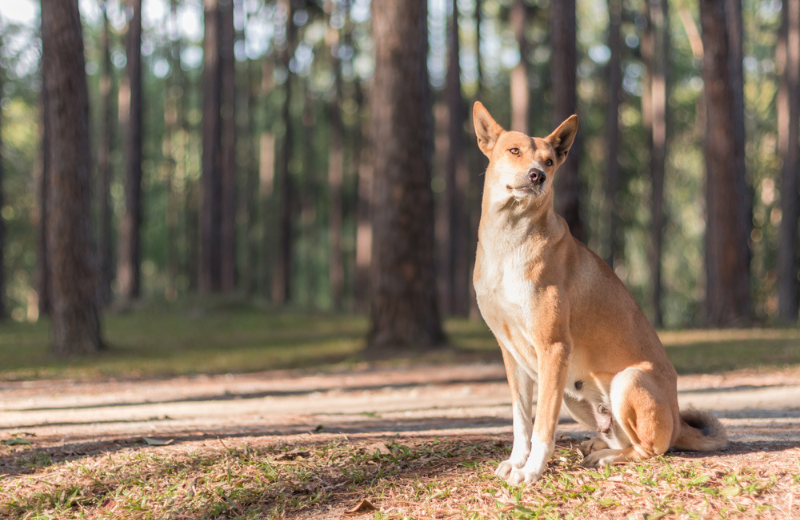
Once your dog is able to stay in position for a longer stretch of time, you can begin to introduce some distance. Start by taking just a step or two back after giving the stay cue, then return to your dog and reward them for holding still. Gradually increase the space between you both as your dog becomes more confident, but avoid making big jumps too quickly.
It’s important to return to your dog to give the reward, rather than calling them over. Recalling is a separate command altogether and should be taught independently. Building this type of distance control is a key part of preparing your dog to stay reliably, even when they’re off the lead.
Step Five: Introduce Distractions
Gradually introduce gentle distractions, like someone walking past, a dropped toy, or a door opening. Reward your dog when they ignore these and hold their stay. This is key to teaching a dog how to stay in real-life situations.
If your dog breaks position, reduce the distraction and try again. Always set them up for success.
Step Six: Add a Clear Release Cue
A stay is only complete when your dog knows exactly when they’re allowed to move again. This is where your release word comes in. Once your dog has held the stay for the desired amount of time, say your chosen release word—like “okay” or “free”—in a clear, cheerful voice. Then encourage your dog to move and reward them once they do.
This helps avoid confusion and makes the boundaries of the command much clearer. It also teaches your dog that staying still has a definite beginning and end, which builds trust and consistency in your training.
What Is the Difference Between Wait and Stay?
Although “wait” and “stay” might sound interchangeable, they’re used in slightly different ways during training. The stay command is used when you want your dog to remain in one place until you come back and release them. It’s often used for longer periods or when you need your dog to stay put while you step away.
In contrast, “wait” is more about a brief pause. You might use it when you’re about to open the front door or before placing down a food bowl—situations where your dog just needs to hold off momentarily until given another cue.
Both commands can be useful, but many trainers suggest teaching stay first, as it helps your dog develop better impulse control and focus early on.
Should I Teach My Dog Stay or Come First?
This depends on your goals, but many trainers suggest teaching stay first because it teaches calmness and helps with other commands. Once your dog can hold position, it becomes easier to teach come. You’ll have more control, and your dog will learn to listen for your signal.
How to Train Your Dog to Stay With You Off-Lead
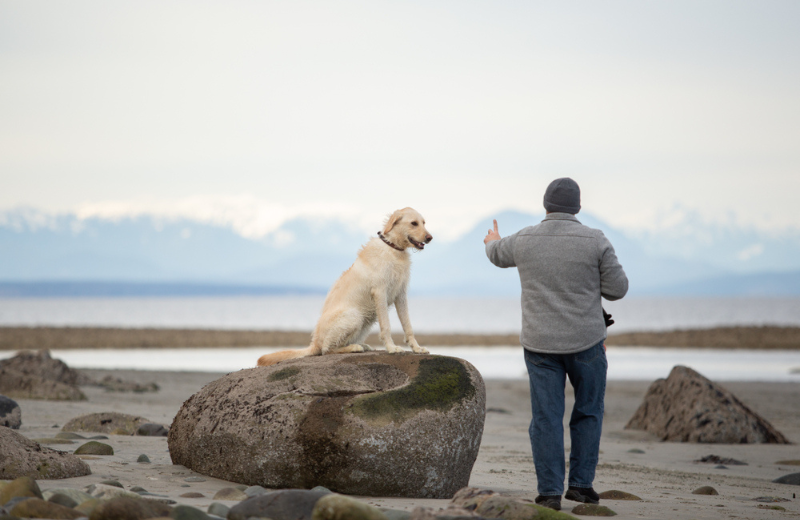
When you feel confident in your dog’s stay, you can begin practising off lead. Start in a secure, quiet area like your garden or a fenced field. Give the stay cue and take a few steps back.
Reward your dog for holding position, then increase the distance gradually. If they break the stay, calmly bring them back and repeat the cue. Never punish; just reset and reinforce what you want.
Eventually, your dog will be able to stay without a lead, even around distractions, as long as you’ve built the skill step by step.
Training Tips and Troubleshooting
If your dog doesn’t stay for long or outright refuses to stay, these tips can help:
- Keep sessions short and upbeat; 5–10 minutes is plenty
- Train in the same place at first, then vary the environment later
- Avoid repeating the stay cue; say it once, then follow through
- Use high-value treats your dog loves
- Be patient; some dogs need more repetition than others
Above all, focus on rewarding the behaviour you want and building trust.
Frequently Asked Questions
Can I teach stay without using treats?
Treats are highly effective for teaching dogs, especially in the early stages. If you’d prefer not to use food, praise, toys, or playtime can also serve as rewards. Just make sure whatever you use is motivating enough for your dog to want to repeat the behaviour.
What age should I start teaching my puppy to stay?
You can begin training as early as eight weeks old. At this age, sessions should be very short—just a few minutes—and focused on encouragement rather than perfection. Even brief moments of staying still are worth rewarding.
How often should I practise the stay command?
Ideally, practise stay once or twice a day in short, focused sessions. Regular repetition helps your dog understand what’s expected and builds a more reliable stay over time. Practising in different environments also helps reinforce the behaviour.
What if my dog only stays when they can see the treat?
This usually means your dog is responding to the visible reward rather than the cue itself. Try hiding the treat behind your back or in your pocket. Only reward after your dog successfully completes the stay—this helps shift their focus from the treat to the behaviour.
Can I use the stay command when my dog is standing?
Stay can be applied to any position—standing, sitting, or lying down. Most training starts with sit or down as they’re easier for dogs to hold, but once your dog understands the command, you can apply it to other positions as needed.
Is it ever too late to teach an older dog to stay?
Not at all. Dogs of any age can learn new commands, including stay. Older dogs may take a little longer if they’re set in their ways, but they’re often very capable and willing learners with consistent, positive training.
Why does my dog break the stay as soon as I move?
This is a common issue and often means your dog isn’t yet confident with the added challenge. Take smaller steps away at first, literally one step, then return and reward. Gradually build distance as your dog’s understanding improves.
How can I tell when my dog is ready for more advanced stay training?
If your dog can hold their stay for at least 30 seconds with minor distractions and short distances, they’re ready to move on. From there, you can practise outdoors, add more distractions, or work on off-lead stays in secure spaces.
Recommended for you!
Best SellersStudy Our Dog Training Diploma for £29
If you're ready to deepen your understanding and become a confident, knowledgeable trainer, consider taking the Dog Training Diploma Course with Centre of Excellence. Whether you're a dog owner, aspiring trainer, or simply passionate about canine behaviour, this course offers comprehensive guidance suitable for all levels. And right now, you can enrol for just £29.

